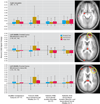Response to emotional expressions in generalized social phobia and generalized anxiety disorder: evidence for separate disorders
- PMID: 18483136
- PMCID: PMC2855133
- DOI: 10.1176/appi.ajp.2008.07071060
Response to emotional expressions in generalized social phobia and generalized anxiety disorder: evidence for separate disorders
Abstract
Objective: Generalized social phobia involves fear/avoidance, specifically of social situations, whereas generalized anxiety disorder involves intrusive worry about diverse circumstances. It remains unclear the degree to which these two, often comorbid, conditions represent distinct disorders or alternative presentations of a single, core underlying pathology. Functional magnetic resonance imaging assessed the neural response to facial expressions in generalized social phobia and generalized anxiety disorder.
Method: Individuals matched on age, IQ, and gender with generalized social phobia without generalized anxiety disorder (N=17), generalized anxiety disorder (N=17), or no psychopathology (N=17) viewed neutral, fearful, and angry expressions while ostensibly making a simple gender judgment.
Results: The patients with generalized social phobia without generalized anxiety disorder showed increased activation to fearful relative to neutral expressions in several regions, including the amygdala, compared to healthy individuals. This increased amygdala response related to self-reported anxiety in patients with generalized social phobia without generalized anxiety disorder. In contrast, patients with generalized anxiety disorder showed significantly less activation to fearful relative to neutral faces compared to the healthy individuals. They did show significantly increased response to angry expressions relative to healthy individuals in a lateral region of the middle frontal gyrus. This increased lateral frontal response related to self-reported anxiety in patients with generalized anxiety disorder.
Conclusions: These results suggest that neural circuitry dysfunctions differ in generalized social phobia and generalized anxiety disorder.
Figures



References
-
- Stein MB, Kean YM. Disability and quality of life in social phobia: epidemiologic findings. Am J Psychiatry. 2000;157:1606–1613. correction 157:2075. - PubMed
-
- Pine DS, Cohen P, Gurley D, Brook J, Ma Y. The risk for early-adulthood anxiety and depressive disorders in adolescents with anxiety and depressive disorders. Arch Gen Psychiatry. 1998;55:56–64. - PubMed
-
- Bruce SE, Machan JT, Dyck I, Keller MB. Infrequency of “pure” GAD impact of psychiatric comorbidity on clinical course. Depress Anxiety. 2001;14:219–225. - PubMed
-
- Coelho HF, Cooper PJ, Murray L. A family study of co-morbidity between generalized social phobia and generalized anxiety disorder in a non-clinic sample. J Affect Disord. 2007;100:103–113. - PubMed
Publication types
MeSH terms
Grants and funding
LinkOut - more resources
Full Text Sources
Other Literature Sources
Medical

